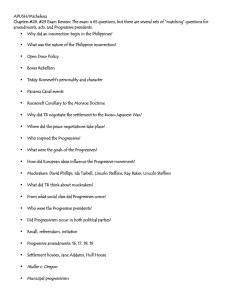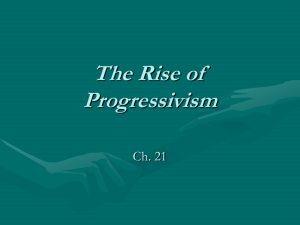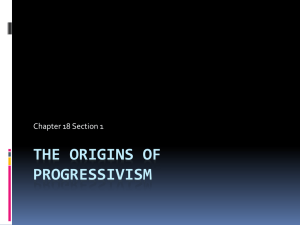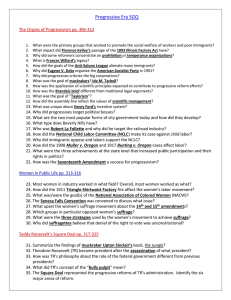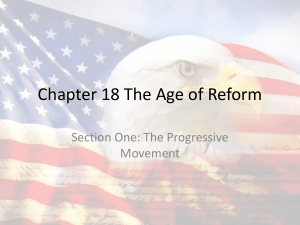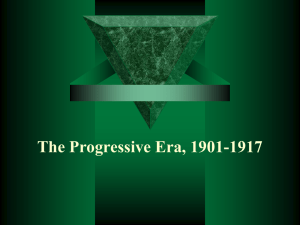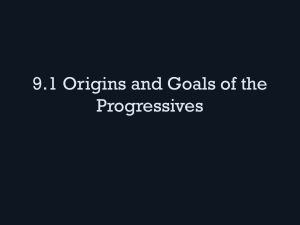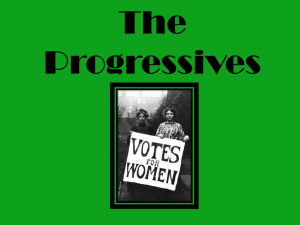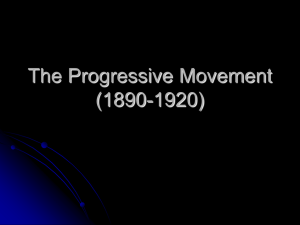Student ppt Chapter 21
advertisement
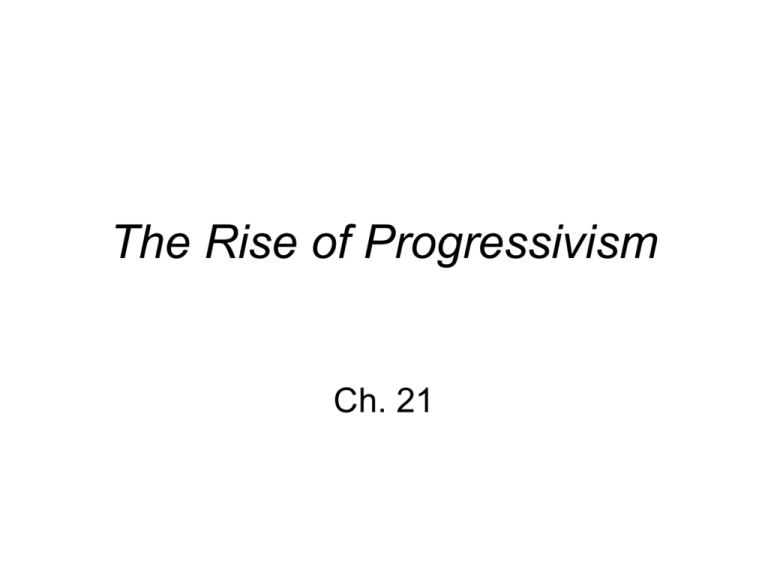
The Rise of Progressivism Ch. 21 I. The Progressive Impulse • Direct, purposeful human intervention in social and economic affairs was essential to ordering and bettering society. Laissez faire and Social Darwinism looked upon as inefficient to maintain order. • • Varieties of Progressivism Progressives often disagreed – Spirit of “Anti-monoply” • • – Social cohesion • • • – Faith in knowledge • • – Increasing the role of government • • • – Incompatible Philosophies? The Muckrakers – term coined by TR in accusation that they were raking up muck – – Muckrakers – Individuals • • • Charles F. Adams (1860s) = railroad Ida Tarbell (1904) = Standard Oil Lincoln Steffens = Political Machines Charles F. Adams Ida Tarbell The History of the Standard Oil Company Lincoln Steffens Shame of the Cities Chapters of Erie – Other areas of influence • • – Reached peak of influence in first decade of the 20th century – Inspired Americans to take action and echoed progressive ideals The Social Gospel – Social outrage combined with a humanitarian sense of social responsibility helped produce many reformers who were committed to social justice – – – Salvation Army • • • • committed to offering both material – Individual contributions • Charles Sheldon’s In His Steps: 15 million copies • Walter Rauschenbusch: Darwinism not survival of the fittest, but rather all should work to ensure a humanitarian evolution into the social fabric • • The Settlement House Movement – Where Social Darwinists (William Graham Sumner) argued that people’s fortunes reflected their inherent “fitness”, progressives disagreed… Ignorance, poverty, even criminality were not the result of inherent moral or genetic failings they were, rather, the effects of an unhealthy environment. – The Settlement House Movement Continued – Hull House (1889), Chicago • • • • Helped immigrant families adapt to the language and customs of their new country Middle class had a responsibility to assist and educate immigrants The Settlement House Movement Continued – Role of college women • • • – The Birth of Social Work • • The Allure of Expertise – Progressives placed high value on knowledge and expertise – Non-scientific problems could be solved with science – Belief that well designed bureaucracies could create the stability and order America needed – Whereas S.Darwinism sought to justify the current system, these progressive intellectuals sought to create a new society • – Pros and cons… where progressives disagree • • The Professions – Birth of a new middle class • • – American Medical Association (1901) • • – – – – Professional Bar Associations (1916) National Association of Manufactures (1895) United States Chamber of Commerce (1912) Some professionals used admission requirements to exclude women and minorities Women and Professions – Most women were excluded from most of the emerging professions, but many did find ways to enter professional careers – 1900 5% of all physicians were female… a proportion that remained unchanged until the 1960s – – Women and Professions Continued – – – the “women professions” common traits with progressivism in that they established a professional identity – differed in that they had a vaguely “domestic” or “helping” image Women and Reform The progressive era represented both an expansion of women’s separate sphere and a confirmation of it The “New Woman” • housework taking up less time of the day – – – • Less Children and longer lives = more time alive without children around The “New Woman” Continued – “Our failures marry” • • • • • many women believe that only by remaining single could they play the roles they envisioned in the public world 10% of all women never married in the last decades of the 19th century… high proportion of them were middle class The “New Woman” Continued Again – – “Boston Marriages” in secret Divorce rates rise • • – The role of higher education and women’s colleges • • – Un-definable yet shifting identity of woman both defined and limited their public activities The Clubwoman – large network of women’s associations grew rapidly between 1880s and 1890s – became the vanguard of many important reforms – formed to give women an outlet for intellectual energies – General Federation of Women’s Clubs • • Clubwoman Continued – In the early half of the twentieth century focus shifts to social betterment – Many women were from wealthy families – African American women formed clubs of their own • • • The Clubwoman Continued Again – Few women actually believed that traditional gender roles were “exploitive and obsolete” (Charlotte Perkins Gilman 1898) – Much of what they did was uncontroversial • • • … and once again. – Some of what they did was controversial • • • • • • • • important force is passing state and federal laws against child labor And Again – Alliances formed between women’s groups • • – Early success depended on male interest • • Woman Suffrage Considered the greatest movement during the progressive era… one of the greatest in American history Why was it considered “radical”? • rationale some supporters used to advance it – – • Popular belief was that men and women also believed in separate spheres – – • anti-suffrage newspapers, rallies, petitions and legislatures How did the tide turn? • suffragists became better organized – • Leaders began to justify suffrage in “safer” less threatening ways – – How did the tide turn? Continued • Connection to other issues – – • • Less optimistic reason: If immigrants and black males could vote, “well born” women should be allowed to vote too Supporters played both ends – – Legislative Process • The West leads the way • • • • • East gets caught up – – – Temperance issue: Catholics v. Protestants 1913 Illinois first state East of Mississippi River to grant women suffrage 1917/1918: New York and Michigan, two of the most populous states in the Union Legislative Process Continued • • 1920: 19th Amendment guaranteed the political rights to women throughout the nation Feminist Divisions – –
